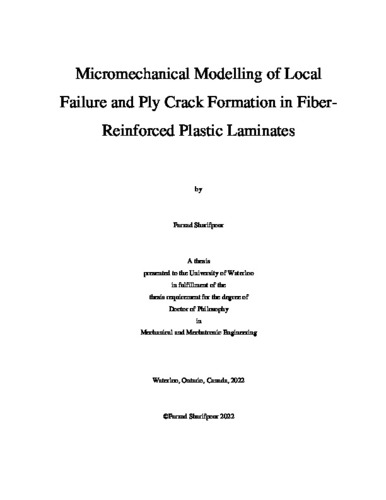| dc.description.abstract | Establishing an understanding of the multiscale nature of progressive failure in laminated fiber-reinforced plastics is required to develop high fidelity failure prediction models for associated structures. In recent years, virtual testing techniques have been proposed as an alternative to costly experimental characterization campaigns for assessing damage of composite laminates at different length scales. Conventional macroscale and mesoscale models have been widely proposed to predict stiffness/strength degradation of laminated composites. Nevertheless, the presence of manufacturing-induced defects (e.g., micro-voids) and the significance of local phenomena at the microscopic length scale have put into question the fidelity of conventional approaches (e.g., homogenization of internal structures) for predicting the mechanical performance of composite materials. Progressive failure of composite laminates under quasi-static and cyclic loading begins with formation and multiplication of ply (intralaminar) cracks. Physically, ply cracks form due to the linkage of local failures at the microscale, while they can influence the behaviour of the material at larger scales. The overall goal of the thesis is to develop computational micromechanical models to assess the process of ply crack formation in carbon fiber/epoxy [0/90/0] cross-ply laminates, while also integrating with a hierarchical multiscale framework to bridge the micro and mesoscales. At the microscale, the initiation of local failure in epoxies is related to cavitation-induced and pressure-dependent ductile failure. A constitutive model within a finite element framework was developed to capture the onset of local failure in the epoxy matrix, while an isotropic damage model was used to capture the progression of ply cracks. Manufacturing-induced defects (e.g., micro-voids, resin-rich pockets, inter-ply resin-rich zones), and thermal residual stresses that result from cooldown of the manufactured material after curing were represented in the computational models. The effect of the ply constraints on local stress and displacements fields before and after the formation of ply cracks was also investigated by considering the constraining plies within the representative volume elements generated in this study. Micromechanical models with constrained 90° plies subjected to a thermal cooldown followed by a tensile load revealed that the local dilatation energy density in the matrix increased when compared to that in the unconstrained lamina, which promoted brittle cavitation at lower applied strains. Furthermore, the significance of capturing inelastic deformation of the matrix for predicting ply crack formation in cross-ply laminates was revealed. Although the formation of ply cracks was found to be governed by brittle cavitation and crack growth, which is consistent with the outcomes of previous studies, local inelastic deformation of the matrix indirectly influenced crack growth. Dissipation of energy during the ply crack evolution process was obtained to approximate the corresponding effective energy release rate, and to provide a link between the local response of a laminate and the response at a higher length scale. The outcomes of this study can be incorporated within a multiscale framework to predict damage evolution in laminated composites. For example, a computationally measured strain energy release rate for ply cracking can be used to calibrate mesoscale or macroscale damage prediction models and be utilized within a synergistic damage mechanics multiscale framework to predict stiffness/strength reduction of a laminate. | en |

